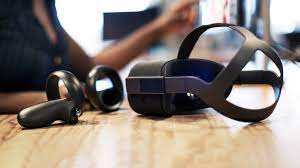Geek Life: Fun stories, memes, humor and other random items at the intersection of tech, science, business and culture. SEE MORE
Oculus Santa Cruz
A screen grab from the Oculus video showing the “Santa Cruz” prototype. (Via YouTube)
Virtual reality fans are spinning over the unveiling of an Oculus prototype that removes the wires and/or the phone from its traditional headsets (Rift and Samsung Gear) and sends users into an untethered world.
Teased by Facebook CEO Mark Zuckerberg at the Oculus Connect developers conference, the “Santa Cruz” prototype was shown in action in a short video on the Oculus website. The all-in-one device features a computer at the back of the headset and inside-out positional tracking to let a user wander around a room untethered.
The company says it has “made a ton of progress on the software for inside-out tracking that makes this whole category possible.” And Max Cohen, head of mobile for Oculus, told Mashable that the combination of cameras on the headset track a user’s movements in relation to objects in a room, “sampling the environment” and “looking around at objects that it can then recognize.”
Several journalists were allowed to demo the device at the conference. Here’s a sampling of what they experienced:
“Imagine a version of Gear VR that doesn’t use your phone while giving you a room-scale virtual reality experience, and you get the idea. The Gear VR doesn’t even know if you lean forward, but Santa Cruz … allows you to get up and walk around. A blue grid appears when you get too close to a wall. — Polygon.
“The three-minute demo consisted of two different animated scenes. One was a suburban neighborhood and the other a rooftop whee you could look down on the buildings around you. The overall image quality lay somewhere between the Samsung Gear VR and the Rift. The graphics were cartoon-like and pretty cheesy but the experience was meant to demonstrate the untethered concept of the prototype more than anything else.” — Mashable.
“It’s worth noting that it’s a pretty tiny processor mounted on the back of this headset, under a heatsink and cooling fan. Even if you’re untethered, you won’t be playing games quite as graphically amazing as the ones you’d play with a Rift hooked up to a powerful gaming PC.” — CNET.

Oculus Santa Cruz
A screen grab from the Oculus video shows a tester roaming without wires. (Via YouTube)
“The team admitted that the tracking only worked optimally when certain environmental conditions were met. The room I demoed “Santa Cruz” in was very well lit which was hinted to be somewhat essential to this particular prototype. It was also a fairly tight space with plenty of knick knacks on the walls that likely operated as clear points of reference for the computer vision that was actively mapping the space — I was also told open spaces were not ideal for this prototype.” — TechCrunch.
“During my short demo, I was able to walk around in an open virtual space, watching a vibrant cityscape in front of and all around me. The system did an admirable job of tracking where I was in space—popping up a virtual wall when I neared the actual wall in the room I was physically standing in. … I have to be honest: It was pretty cool. There was nothing about this demo, to be sure, that a Vive couldn’t surpass—except for the fact that this was entirely wireless, with no extremal sensors.” — Fast Company.
“It wasn’t quite perfect. Occasionally, the world swam a tiny bit, as though it were getting its bearings around me. But Santa Cruz mimicked my actual head and body motion extremely precisely. Over the couple of minutes I used it, I was able to look around, walk, crouch, and shake my head without it ever losing track of me. In a lot of ways, it felt just like using a backpack PC with an HTC Vive, but with no backpack or external setup.” — The Verge.
